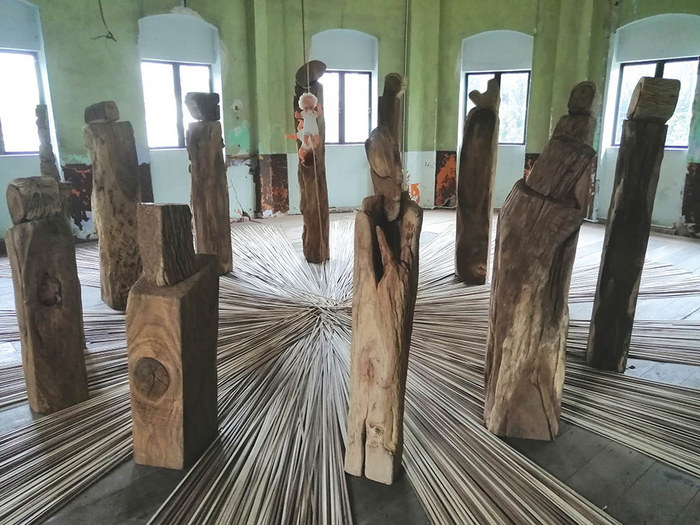Art Ipoh 2019


By Chris Teh
Ipoh’s first ever major art exhibition, Art Ipoh, which was launched on August 17, saw the display of 36 installation art pieces. This art project focuses on the utilisation of reclaimable and recyclable materials, while integrating societal issues into the creative process to highlight certain problems faced by the community today, such as homelessness and loss of cultural inheritance.
Tan Kai Lek, founder of Tin Alley, where the art exhibition is happening, said that 18 artists in-residence, which consists of eight local artists and 10 artists from out of Ipoh, contributed to the whole project under the helm of Kuala Lumpur-based Philip Wong, co-artistic director and curator of Art Ipoh 2019.
“Tin Alley serves as a platform not only for artists to showcase their installation pieces, but also for any meaningful causes which can bring a positive impact to the community,” he mentioned. “For the 18 artists in-residence, installation art, which is also the theme for this exhibition is something exciting because it’s also their first ever hands-on experience.”


According to Tan, art pieces range from 50 sq ft to 1000 sq ft. Wood was mainly used as the material for the exhibit art pieces where artists carved and painted.
“The century-old double-storey shophouses, where Tin Alley is located, is already an art piece itself. The many characteristics of the building is where our artists draw inspiration from. Basically, this shophouse is a seed to many creative ideas,” he further explained. “For example, the walls in this shophouse have been limewashed. Given the age of shophouses, very few buildings in Ipoh have the same wall lining because people usually go for normal paints.”
Tan, who is also managing director for Bukit Merah Wood Products Sdn Bhd felt proud that the artists have not given up on this point.
“I really admire Philip Wong for having a systematic direction,” he expressed. “Which is why Tin Alley did its best to support the artists in any way, materials wise and anything else with no conditions. I offered to have artists construct their pieces at my factory in Lahat since installation art pieces use mostly wood.”
As with any project worth undertaking, Tin Alley had its share of challenges. Tan said that the project was initially belittled by everyone around his circle.
“People were always asking me why would I bother with an old and dilapidated building like this shophouse. I understand them because it all comes back to realistic economic concerns. Restoring ancient buildings is not easy. But I told them that if there aren’t people who care about heritage, all these buildings will eventually be extinct,” he lamented.
Occupying the walls with wooden boards, these are what catches the eye once stepping into Tin Alley’s entrance.


“Now that the world is getting more and more modernised due to the increasing proficiency in English and technological advances, historical elements like these Chinese wooden boards mean near to nothing to the younger generation today, because they don’t understand what they signify in the first place!” he bemoaned.
“This is why Chew’s works are on permanent display at Tin Alley. We would like to commemorate his hard work,” Tan expressed.
“Another concern is that the general public does not understand the definition of ‘art’ adequately, not to mention installation art,” he highlighted.
Speaking his mind about society today, Tan said, “I would categorise it as a disease that people tend to follow public opinion before their own. It is like the concept of yin and yang. The public has their perspective limited to just the shallow perspective of art. Most of the people I know are skeptical when it comes to art, saying it’s a waste of their time.”
Further highlighting, he said, “This is why people are quick to judge.”
“Through this art exhibition, I hope I can inspire people to look at the better and deeper side of things in life and also to understand history,” he added. “There is a reason why our ancestors left a legacy. Everything had been laid out for us. It is up to our generation to continue conserving it and passing it on to the future generation. We should not take their hardships in the past for granted.”
Tan also highlighted that Yuk Choy High School is the only school remaining in Ipoh which still offers art classes.
“This is why we featured students from Yuk Choy for our exhibition,” he mentioned. “Art is something that is open for interpretation by all walks of life and beneficial to education and life in a whole.”


“If artists created something without real life inspiration, the public will not take an interest in looking at it,” he explained. “For instance, in the case of Abu House, which draws inspiration from a homeless man named Abu, it is designed in a way that allows individuals without a roof over their head to stay in it.”
Another art piece worth mentioning is none other than Tan’s “Adoption”, built with tree branches, leaves and trunks.
Inspired by seeing the cutting down of a century-old tree 20 years ago, Tan took the wood which were meant to be dumped back to his workshop, to be repurposed.
“By reusing old tree parts, I’m able to give trees a new purpose to their existence,” he explained.
Open for interpretation to the public are Philip Wong’s installation of dangling baby dolls surrounded by wooden sculptures resembling ancestors and Sivarajah Natarajan’s installation of bird’s nests which was described as representing the fragility of life.
Both installations can be viewed at the last shophouse along Lorong Bijeh Timah.
For readers interested in the art installations, better get going to Tin Alley to feast your eyes on what Art Ipoh 2019 has to offer before the exhibition ends on September 30!
Tin Alley
No. 3 Lorong Bijeh Timah, 30000 Ipoh.
Contact: 019 512 1801 (Mr Leong)
Operation hours: 10am till 6pm




